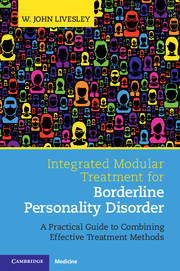 Integrated Modular Treatment for Borderline Personality Disorder
Integrated Modular Treatment for Borderline Personality Disorder Book contents
- Frontmatter
- Dedication
- Contents
- Preface
- Section 1 Introduction and Framework for Understanding Borderline Personality Disorder
- 1 Introduction
- 2 Understanding Normal and Disordered Personality
- 3 Understanding Borderline Personality Disorder
- 4 Origins and Development
- Section 2 Assessment and Treatment Planning
- Section 3 General Treatment Modules
- Section 4 Safety, Containment, and Engagement: The Initial Phase of Treatment
- Section 5 Improving Emotional Regulation and Modulation
- Section 6 Exploration and Change: Treating Interpersonal Problems
- Section 7 Constructing an Adaptive Sense of Self
- Section 8 Retrospect and Prospect
- References
- Index
2 - Understanding Normal and Disordered Personality
from Section 1 - Introduction and Framework for Understanding Borderline Personality Disorder
Published online by Cambridge University Press: 16 February 2017
- Frontmatter
- Dedication
- Contents
- Preface
- Section 1 Introduction and Framework for Understanding Borderline Personality Disorder
- 1 Introduction
- 2 Understanding Normal and Disordered Personality
- 3 Understanding Borderline Personality Disorder
- 4 Origins and Development
- Section 2 Assessment and Treatment Planning
- Section 3 General Treatment Modules
- Section 4 Safety, Containment, and Engagement: The Initial Phase of Treatment
- Section 5 Improving Emotional Regulation and Modulation
- Section 6 Exploration and Change: Treating Interpersonal Problems
- Section 7 Constructing an Adaptive Sense of Self
- Section 8 Retrospect and Prospect
- References
- Index
Summary
This chapter begins to develop a framework for understanding borderline personality disorder (BPD) by describing the structure of normal personality and how this structure is impaired in BPD. However, first I am going to introduce the case of Anna, which will be used throughout the book to illustrate assessment, treatment planning, and intervention strategies. Here the case is used to discuss the range of problems and psychopathology seen in BPD.
The Case of Anna
Anna was 36 years old, married with three children, when she was assessed following a brief hospital stay due to a serious drug overdose. Anna said that the overdose was triggered by a fight with her husband that caused intense distress and she became afraid that he would leave her. Feeling overwhelmed and unable to cope, she took an overdose. Such crises were common and she had several previous admissions for self-harming behaviour. Most of the time her feelings were “all over the place,” and she felt depressed and persistently worried “about every little thing.” Although, there were times when she wondered if these feelings were real. She also had uncontrollable rages, especially with her husband. She also had chronic thoughts of suicide.
Anna's upbringing was characterized by family dysfunction, physical and emotional abuse, and childhood sexual abuse. Her marriage was unstable. She and her husband fought constantly and he was emotionally abusive. The relationship was typical of many previous relationships. Anna commented that she always seemed attracted to the wrong kind of men but she was unable to leave her husband because she did not have the financial resources. She later explained that she was also afraid to live alone and that she was terrified of being abandoned and needed to feel loved. As a result, she became very dependent on the men she was involved with. Currently, she was afraid of being abandoned and constantly sought her husband's reassurance that he would not leave. This fear caused her to submit readily to his demands and go out of her way to placate him.
- Type
- Chapter
- Information
- Integrated Modular Treatment for Borderline Personality DisorderA Practical Guide to Combining Effective Treatment Methods, pp. 14 - 28Publisher: Cambridge University PressPrint publication year: 2017


